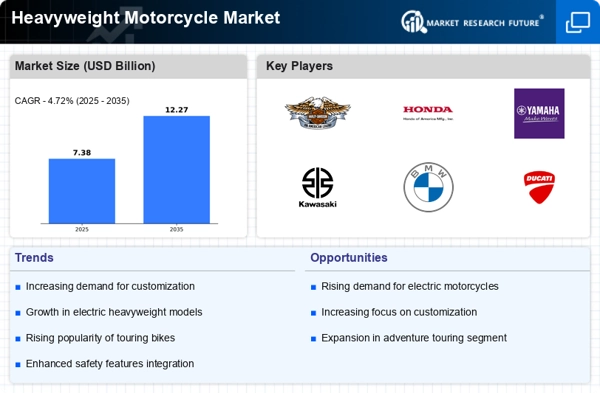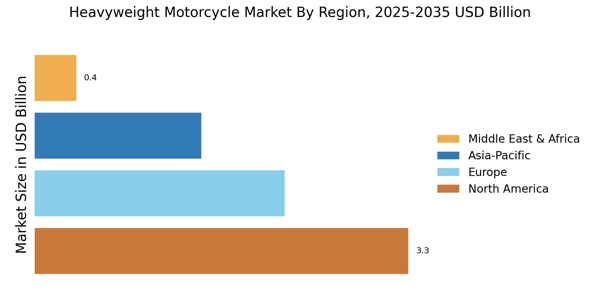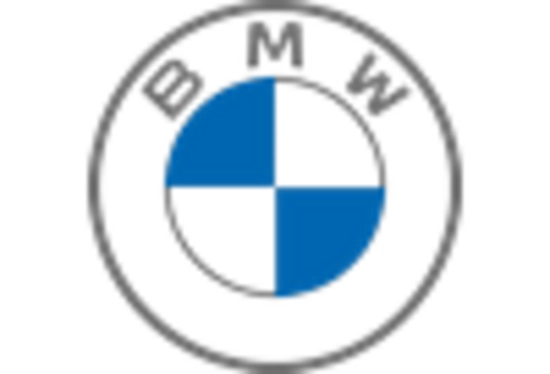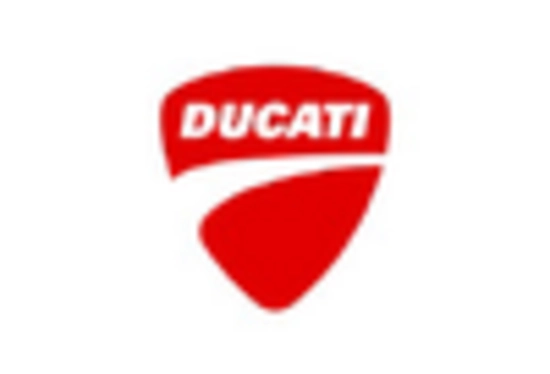Increasing Disposable Income
The Heavyweight Motorcycle Market Industry appears to benefit from rising disposable income levels among consumers. As individuals experience an increase in their financial capacity, they are more inclined to invest in premium motorcycles, which are often characterized by their heavyweight classification. This trend is particularly evident in regions where economic growth is robust, leading to a surge in demand for luxury and high-performance motorcycles. Market data indicates that the heavyweight motorcycle segment has seen a notable increase in sales, with a projected growth rate of approximately 5% annually over the next few years. This financial empowerment allows consumers to prioritize leisure activities, including motorcycle riding, thereby driving the Heavyweight Motorcycle Market Industry forward.
Growing Interest in Adventure Tourism
The Heavyweight Motorcycle Market Industry is likely experiencing a surge in interest due to the growing popularity of adventure tourism. As more individuals seek unique travel experiences, heavyweight motorcycles are increasingly viewed as ideal vehicles for long-distance journeys and off-road adventures. This trend is supported by market data suggesting that adventure tourism has expanded significantly, with a projected annual growth rate of around 7% in the coming years. Heavyweight motorcycles, known for their durability and comfort, are well-suited for such endeavors, attracting a demographic that values exploration and adventure. Consequently, this growing interest in adventure tourism is expected to bolster the Heavyweight Motorcycle Market Industry, as more consumers invest in motorcycles that enhance their travel experiences.
Technological Advancements in Motorcycle Design
The Heavyweight Motorcycle Market Industry is witnessing a transformation driven by technological advancements in motorcycle design. Innovations such as improved engine efficiency, enhanced safety features, and advanced connectivity options are becoming increasingly prevalent. These advancements not only enhance the riding experience but also appeal to a tech-savvy consumer base. Market data indicates that motorcycles equipped with advanced technology are gaining traction, with sales in this category expected to rise by approximately 6% annually. As manufacturers continue to integrate cutting-edge technology into heavyweight motorcycles, consumer interest is likely to grow, further propelling the Heavyweight Motorcycle Market Industry. This trend suggests that the future of heavyweight motorcycles will be characterized by a blend of performance and technology.
Environmental Regulations and Sustainable Practices
The Heavyweight Motorcycle Market Industry is facing a shift due to increasing environmental regulations and a growing emphasis on sustainable practices. As governments implement stricter emissions standards, manufacturers are compelled to innovate and develop more environmentally friendly heavyweight motorcycles. This shift is reflected in market data, which shows a rising demand for electric and hybrid heavyweight motorcycles, projected to grow by approximately 8% annually. Consumers are becoming more conscious of their environmental impact, leading to a preference for sustainable options. Consequently, the Heavyweight Motorcycle Market Industry is likely to evolve, with manufacturers focusing on eco-friendly technologies to meet regulatory requirements and consumer expectations.
Rising Popularity of Motorcycle Clubs and Communities
The Heavyweight Motorcycle Market Industry is potentially benefiting from the rising popularity of motorcycle clubs and communities. These social groups foster a sense of belonging among motorcycle enthusiasts, encouraging individuals to purchase heavyweight motorcycles to participate in group rides and events. Market data suggests that membership in motorcycle clubs has increased, leading to a corresponding rise in heavyweight motorcycle sales. This trend indicates that the social aspect of motorcycle ownership is becoming increasingly important, as consumers seek not only a mode of transportation but also a community experience. As more individuals join these clubs, the Heavyweight Motorcycle Market Industry is likely to see sustained growth, driven by the collective enthusiasm of its members.


















Leave a Comment